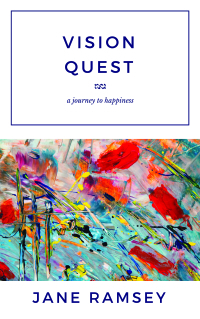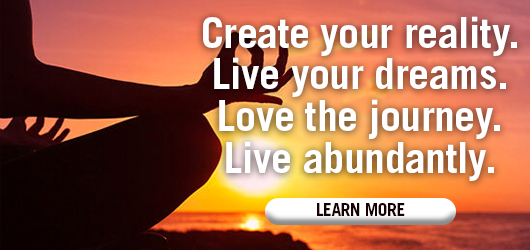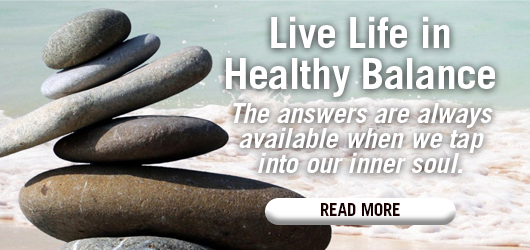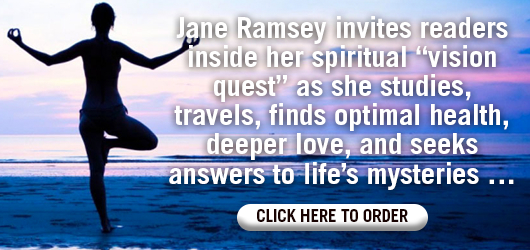As you peer down the mysterious path of your future, do you imagine your life as a blank canvas, to be thoughtfully filled in with meaningful work and relationships? Or, are you more of a here-and-now type, believing existence to be a conscious state, and that memories, emotions, and everything else are just illusions created by the mind? Of course, there’s other schools, other theories about the nature of our existence that you may subscribe to, but the one thing most of us have in common is the burning desire to know the purpose of this life of ours.

Jane Ramsey understands the call to spiritual fulfillment. In her acclaimed new book Vision Quest, Jane Ramsey offers seekers from all walks of life loving and compassionate guidance to connecting with the higher self. Prior to her spiritual/philosophical pursuits, including her certification as a meditation teacher with the Chopra Center, Jane spent thirty-six years in corporate America. More recently, she’s developed courses in SoulArt Meditation and Primordial Sound Meditation to help practitioners be more balanced, creative, and intuitive.
Intrigued by her unique spiritual path, Foreword’s editorial team reached out to Jane with a series of expansive questions about Vision Quest, her favorite spiritual books and leaders, and other existential matters. We’re certain you’ll be intrigued by her ideas.
First and foremost, for people who may be unfamiliar with the terminology, what would you give as a general definition of a vision quest? In your case, what specifically were you seeking?
In my vision quest, I was seeking meaning; answers to existential questions like why are we here? and what is the purpose of life? I wanted to find out how scholars and learned people find answers. Many teachers agree that the purpose of an individual life is something akin to be all you can be. I also believe it is about finding your own path to happiness. The size of the stage for the production of life is not what matters. One person can have a huge impact and find joy and deep meaning by interacting with family, friends, or seeming strangers. The ancient teachers encouraged their students to take nothing on faith and to question everything.
Human beings cannot live without challenge.
We cannot live without meaning.
Everything ever achieved we owe to this inexplicable urge to reach beyond our grasp, do the impossible, know the unknown.
(Anonymous, The Upanishads)
The Upanishads would say this urge is part of our evolutionary heritage, given to us for the ultimate adventure: to discover for certain who we are, what the universe is, and what the significance of the brief drama of life and death is we play out against the backdrop of eternity.
You joke in the book that your vision quest was less coming-of-age and more coming-of-old-age. Would you say choosing to start this journey later in life helped or hindered the process for you? And what would you say to those seekers who feel they’re too old or too set in their ways to begin a quest?
I think everyone’s path is unique and new adventures unfold when the timing is right. One of my beloved teachers, Jean Houston, says that we are all works in progress. She explains that most of us are dull and exhorts us to “Stop boring God!” As a late-bloomer, I felt like a complete beginner among more seasoned, experienced, often younger people who had been on a spiritual path for longer than I had. But, I reminded myself to embrace my beginner status and even relish the process of discovery and learning. I am inspired to stop boring God. I would say to anyone who feels a tug or a pull to seek, to learn, to go on this type of adventure. Listen to that call. It may be the universe saying, “Wake up! There is more here for you to learn!”
You set out on this year-long journey shortly after retiring. What baby-step activities would you recommend for those who are curious about connecting with and enhancing their mind, body, and spirit, but either can’t or aren’t ready to take that big of a step?
I would suggest they ask themselves daily what they have done to nurture mind, body, and spirit today. Progress can be made by taking simple steps. His Holiness the Dalai Lama asks, “How do you create peace? Smile at your neighbor.” Meditation helps nurture mind, body, and spirit. The best advice I give people to access their own inner wisdom is to begin or strengthen a daily meditation or other contemplative practice.
Techniques abound. Find one that resonates and stick with it. Following any of the Oprah and Deepak Chopra 21-day guided meditation series is a wonderful way to begin. I also host a free online 30-minute group meditation on Wednesday afternoons and everyone is welcome. You can join from anywhere.
A number of books from various scholars and luminaries are mentioned in Vision Quest, and they all seem to have been very helpful to you in different ways. If you had to choose only one to recommend to anyone curious about undertaking their own vision quest, what would it be and why?
I think everyone’s path is unique and will begin to unfold in a format and language that resonates. Often for people on a path, articles, books, YouTube videos, or podcasts show up in synchronicity just after they pose the next question in their journey.
For my path, Deepak Chopra resonates strongly with me, but for someone else it may be another teacher. The first book I most often refer to my students is The Seven Spiritual Laws of Yoga, by Deepak Chopra and David Simon.
Your traditional Catholic upbringing and family feature quite prominently in some sections of the book. What would you say to people who perceive a conflict between traditional Christianity and the broader spiritual practices and teachings in your book?
One of my favorite poems is “Outwitted” by Edwin Markham:
He drew a circle that shut me out—
Heretic, rebel, a thing to flout.
But Love and I had the wit to win:
We drew a circle that took him in!
We all have the right to choose our own belief systems and not just adopt, by default, those beliefs that are thrust on us by someone else.
Many people follow a certain faith but also have a wide enough perspective to appreciate broader views. Though millions of people hold that their personal belief system about God is the only correct one, millions more reach out with curiosity to see what has interested others and to enlarge their understanding and awareness.
I think of priests who welcomed divorcees and gay people to mass during times when this was not a typical practice in Catholicism. Many Christians believe in reincarnation. Though the view from the pulpit may be that there is only one exclusive group that can get to heaven, someone in the congregation can have more breadth in their private view.
In examination, it’s possible that someone may delve into what they believe and realize the wisdom tradition they are following is the right path for them. I believe there are many paths on the road to enlightenment and they are all valid.
I wrote my dad a letter on his 90th birthday. He was a devout Catholic and went to mass daily. In the letter, I thanked him for his lifelong example of deep spirituality and said: “I believe that the face of God looks different to different people but that we all can get to the same place, entering the same beautiful room from different doors. I’m grateful for the belief in a soul, in immortality, and in the idea that there is something bigger than each of us, that we will be together again after this life.”
I will always feel connected to Catholicism and I have been inspired my entire life by the devotion of my dad and other members of my family. I have a close cousin and friend who is called Clara in the book. I admire the way she works “within the system” of the Catholic church to modernize views and broaden roles for women. I follow Pope Francis in the news and send him positive intentions and support.
I still feel welcome in the church. I read the work of many current priests including Father Richard Rohr. In my travels, I often stop into a Catholic church for a meditation break. My siblings and I made an audio recording of the rosary for my dad and I played the recording for him on his last day in this life. We were all comforted by my dad receiving last rites. I delivered the eulogy at his funeral mass and the priest was very welcoming.
Christianity and Catholicism are woven into the fabric of my belief system. I was gratified to learn that many Hindu teachers are followers of Christ, including Paramahansa Yogananda, the yogi featured in Autobiography of a Yogi.
The major wisdom traditions all contain some version of a core belief in the Golden Rule. I am particularly drawn to the explanation of “many paths to the same door” in the Bhagavad Gita: Whosoever comes to Me, through whatsoever form, I reach him; all men are struggling through paths which in the end lead to Me.
Painting is a great passion of yours, and you often mention certain pieces were inspired by meditation or retreats. Do you feel painting—or, for that matter, engaging with any art form, including writing—can be a spiritual practice?
Yes, definitely. Both meditation and creating are vehicles for connecting to our higher self; they are both vehicles to help us escape the rigidity of our thoughts. As a meditation teacher, I see the benefits and power of sitting in regular meditation. As an artist, I realize that the act of creating can also be a type of meditation.
The process of painting, writing, composing, making music, cooking—anything creative—can help us tap into a deeper, quieter part of ourselves. We enter into a state of flow and present- moment awareness.
Creative activity can uplift us and help us transcend physical parameters. When we create, just like when we meditate, we can glimpse that place beyond space and time and realize that we are more than our thoughts, our mind, our body.
Our souls can be stirred into expanded awareness looking at a sunrise, a work of art, or listening to music. Creating something can take us to the same place.
Daily practices like meditation and creativity can nurture that spark within us that provides stability, balance, harmony, and a constant connection to our true selves.
Creativity helped me find my post-retirement dharma or purpose. There was something about creating certain shapes, colors, and lightness that made me feel I was tapping into and capturing a specific, higher vibration level. My belief is that if people can access their creativity, it is easier for them to learn how to become fulfilled.
Our finished pieces may not be comparable to a great masterpiece, but the process can be very therapeutic and help us make discoveries along the way. Engaging in any creative activity is about playing, unleashing and connecting to your intuitive and spiritual self. You are not only creating what happens on the paper or canvas; you are the creator of your own reality; your own life.
Both creative expression and meditation can help people become more balanced, to be more grateful, vital, energetic, peaceful, and joyful; to develop greater abundance and loving relationships in their life—to help them find their purpose and use their gifts and talents to live a more full-spectrum life.
Finally, you include a lot of inspirational quotes throughout the book. What would you say is the one that you have found most helpful or applicable—the throw-pillow motto of your life, so to speak?
“We are not human beings having a spiritual experience.
We are spiritual beings having a human experience.”
—Pierre Teilhard de Chardin
Are you currently working on another book? Can you talk about it?
I am currently passionately immersed in developing SoulArt Meditation. My secret dream for a long time was to combine art and meditation and the dream is coming true with the development of this class. In class, each student creates their own Art Journal. I teach some basic painting techniques as well as meditation and breathing techniques.
My students learn to tune in to their own intuition, enjoying the process of creation. Through deep, introspective work, they consider the answers to questions like who am I? and what is my purpose? They identify their unique gifts and talents, their legacy, and examine how they are when they are at their best. We do imagination exercises, get clearer on desires, and learn tools to go deeper in spiritual practice.
The ultimate lesson of the class is that we all have the ability to use more of our potential and create the life we want.
To hear more about SoulArt Meditation, potential students can visit my website: jramseyvisionquest.com.
Jane Ramsey, Vision Quest, 978-1948484718, Clovercroft Publishing, Jramseyvisionquest.com



